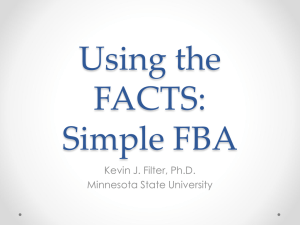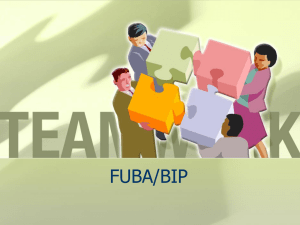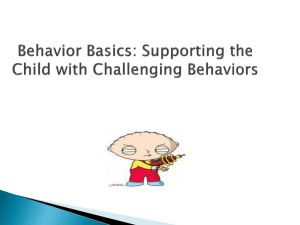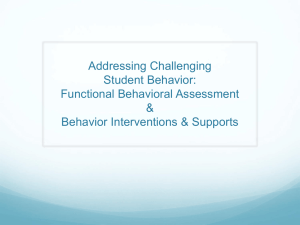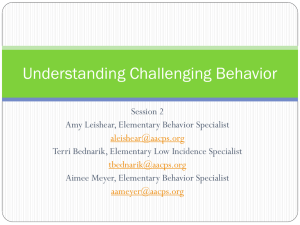Behavior
advertisement
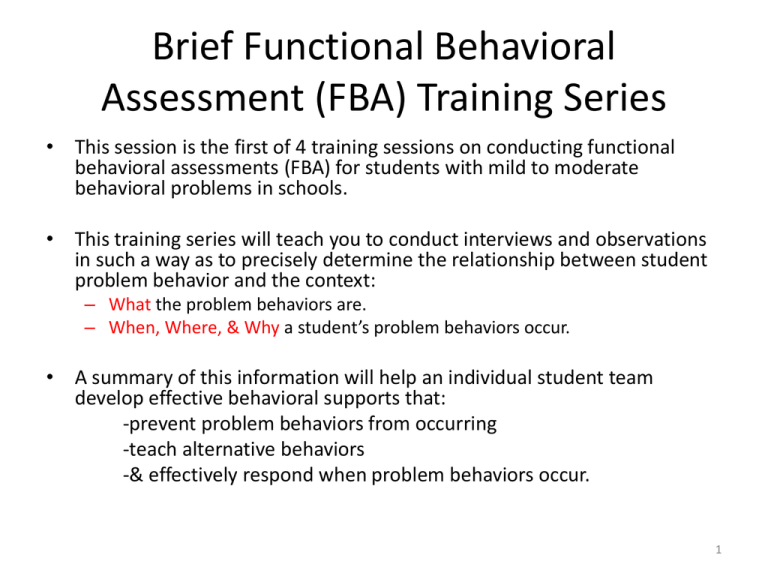
Brief Functional Behavioral Assessment (FBA) Training Series • This session is the first of 4 training sessions on conducting functional behavioral assessments (FBA) for students with mild to moderate behavioral problems in schools. • This training series will teach you to conduct interviews and observations in such a way as to precisely determine the relationship between student problem behavior and the context: – What the problem behaviors are. – When, Where, & Why a student’s problem behaviors occur. • A summary of this information will help an individual student team develop effective behavioral supports that: -prevent problem behaviors from occurring -teach alternative behaviors -& effectively respond when problem behaviors occur. 1 Focus of this training series Brief FBA vs Comprehensive FBA Brief FBA Comprehensive FBA For: Students with mild to moderate problem behaviors (behaviors that are NOT dangerous or occurring in many settings) Students with moderate to severe behavioral problems; may be dangerous and/or occurring in many settings What: Relatively simple and efficient process to guide behavior support planning Time-intensive process that also involves archival records review, familycentered planning, and collaboration with agencies outside of school Conducted by whom: School-based personnel (e.g., teachers, counselors, administrators) Professionals trained to conduct functional assessments with students with severe problem behaviors (e.g., school psychologists, behavior specialists) 2 Brief FBA Brief FBA is an assessment process designed to: -predict the routine & events when a student’s problem behavior occurs. -hypothesize how the behavior pays off for the student (the function of behavior). Your role in the Brief FBA is…. -to be an investigator and collect information that convinces you of where, when, & why a student’s behavior (the what) occurs 3 Requesting a Brief FBA • Teachers & school teams can complete a Request for Assistance form to refer a student for a Brief FBA • Talk to school on obtaining parent permission to conduct a Brief FBA with a student • Request for Assistance should give a broad picture of the student and their behaviors 4 ABC’s of Understanding Why students engage in problem behavior: Finding out the Pay-off or Function of Behavior A= Antecedent(s). Find out the events that occur right before the behavior. – Allows you to predict: Where (During routine)? & When (Trigger event)? B=Behavior. Find out what is the observable problem behavior? C=OutCome/ Consequence. Find out what happens after the behavior occurs? WHY? ABC 5 Brief FBA Always start with the behavior • Despite the ABC concept, the behavior (B) is our starting point! 2 1 3 Antecedent/Trigger: Behavior: Consequence/OutCome When _____ happens…. the student does (what)__ ..because (why) ______ 6 Start with defining observable behaviors • The precision of the definition is important. • It focuses the interventions on the behavior (the What) of concern and ensures that the intervention targets the events that trigger (the Where and When) the behavior and the outcome (Why) of the behavior. • Thus, increasing the likelihood of effective interventions. 7 Defining Observable Problem Behaviors • Definitions of behaviors need to be: – Observable: The behavior is an action that can be seen. – Measurable: The behavior can be counted or timed. – Defined so clearly that a person unfamiliar with the student could recognize the behavior without any doubts! 8 Activity 1 (pg.8) In 30 seconds: List 5 problem behaviors that occur in your school. Go 9 Results of Activity 1 Were your behaviors: – Observable? – Measurable? – Defined so clearly that a person unfamiliar with the student could recognize the behavior without any doubts? 10 Are these observable, & measurable? • • • • • • • Gets out of desk and hits other students Has separation anxiety (from parent) Spacey Reads 120 wpm Says she hears voices Emotionally disturbed Doesn’t like classmates 11 Which is described in observable and measurable terms? • • • • hits with his fist –OR- aggressive bully –OR- takes money from peers psychotic –OR- says she hears voices arrives at class 10 minutes late –ORirresponsible • out of seat 55% of time –OR- hyperactive 12 Tip #1: Ask yourself, “What does the behavior look like?” Talking out: Any verbalization made by the student that was not initiated by the teacher and/or distracts others from the assigned tasks in the classroom. 13 Tip #2 Provide Examples and Non-examples of the problem behavior Examples of Talking Out: Answering a question directed to another student by the teacher. Saying a swear word Talking when the teacher is giving directions Non-examples of Talking Out: Answering a question that the teacher directed to the child. Yelling to another student during recess Talking with a peer during group work 14 Behavior = Talking out Definition: Any verbalization made by the student that was not initiated by the teacher and/or distracts others from the assigned tasks in the classroom. Examples of Talking Out: Answering a question directed to another student by the teacher. Saying a swear word Talking when the teacher is giving directions Nonexamples of Talking Out: Answering a question that the teacher directed to the child. Yelling to another student during recess Talking with a peer during group work 15 Observable/Measurable vs nonobservable/measurable definitions of behavior Observable/Measurable Definition Non-observable/measurable Definition Talks when teacher is lecturing, calling out Disruptive behaviors in a loud voice singing Draws pictures during group work time Off-task behaviors Throwing objects, Kicking over chairs Angry, Hostile Behaviors Calls peers names Inappropriate language Tapping/ drumming on desk, looking around the classroom Attention problems Refusal to do work, failure to follow directions Non-compliance Yells “No” or “You can’t make me” when given direction Defiance 16 Are your definitions so clear that a person unfamiliar with the student could recognize the behavior without any doubts? 17 Remember: Always start with the behavior 1- Once you have defined the behaviors (the What) 2- Then want to know the Where & When the behaviors occur #2 (Routine & Antecedents) -What happens right before the behavior? 2 1 Antecedent/Trigger: Behavior: When _____ happens…. the student does (what)__ 18 Want to find out specific events (antecedents) that trigger the behavior: - WHERE and WHEN the behaviors occur. • Where= Routines where the problem behavior is most likely – Examples: During math class, gym class, lunch, recess) • When= Specific events within a routine that predict the problem behavior – Examples: When given double-digit addition, given directions 19 Where (Routine) & When: Triggers (Antecedents) to the Behavior 1. Specifically identify the routine (Where) in which behavior occurs -examples: During math class…, At the playground…, 2. Identify the event, action, or object that occurs right before behavior (When…) – Signals the behavior – “sets it off” (trigger) • Where (Routine), When (Antecedent) Student does (Behavior) – During lunch, when told to shut up by a peer, Ben hits the student – During language arts, when asked to read aloud in class, Tracy gets up and tells jokes – During circle time, when praised Jessie starts crying 20 Activity 3: Identify the behavior, routine, & antecedent in the following scenarios Frame them in the blanks/boxes with the following statements: Routine: “During _______________” Antecedent/Trigger: Behavior: When _______ The student does __________ 21 Activity 3 Scenario 1: When he goes to math class and peers tease him about his walk, A.J. calls them names and hits them. Going to Math Class Routine: “During ______________” Antecedent/Trigger: When ______ PEERS TEASE ABOUT HIS WALK Behavior: The student does __________ CALLS NAMES & HITS 22 Activity 3 Scenario 2: In math class, Bea stares off into space and does not respond to teacher directions when she doesn’t know how to do a difficult math problem. Math Class Routine: “During _______________” Antecedent/Trigger: When… Doesn’t know how to do difficult math problem Behavior: The student… Stares & does not respond to directions 23 Remember: Always start with the Behavior 1- Once you have defined the behaviors (the What) 2- & know the Where & When the behaviors occur #2 (Routine & Antecedents) 3- Then want to find out WHY (the outCome of the behavior…what happens right afterwards) 2 1 3 Antecedent/Trigger: Behavior: Consequence/OutCome When _____ happens…. the student does (what)__ ..because (why) ______ 24 2 Steps to finding out the WHY Step 1: Determine what happens right after the behavior (the OutCome or Consequence). It may help to think: “because... ______________” • Example (AntecedentBehavioroutCome; ABC) – During recess, when peers tease him, Ben hits his peers and they leave him alone – During reading, When asked to read aloud Tracy tells jokes, the other students laugh, and she is sent to the office (missing the assignment and getting peers attention) – During circle time, when praised Jessie starts crying, the teacher stops circle time and comforts her. (Giving her attention) 25 Activity 4 Scenario #1: Joe throws his pencil and rips his paper during math whenever he is given double-digit math problems. This results in him getting sent to the office. Routine: During ________________ Antecedent/Trigger: When _________ Behavior: Student does _________ Consequence/OutCome: because __________ 26 Activity 4 Scenario #1: Joe throws his pencil and rips his paper during math whenever he is given double-digit math problems. This results in him getting sent to the office. Math class Routine: During ________________ Antecedent/Trigger: When.. Given double-digit math problems Behavior: Student does.. Throws pencil & rips paper Consequence/OutCome: Because.. Sent to the office 27 Activity 4 Scenario #2 Nancy cries during reading time whenever she has to work by herself. This results in the teacher sitting and reading with her. Routine: During ________________ Antecedent/Trigger: When _________ Behavior: Student does _________ Consequence/OutCome: because __________ 28 Activity 4 Scenario #2 Nancy cries during reading time whenever she has to work by herself. This results in the teacher sitting and reading with her. Reading Routine: During ________________ Antecedent/Trigger: When… Has to work by herself Behavior: Student does.. Cries Consequence/OutCome: Because.. The teacher sits & reads with her 29 When Understanding the WHY of behavior: Step 2 • When understanding behavior, we want to learn what function (or purpose) the behavior is serving for the student (what is the pay-off for the student?) • You need to understand from the student’s perspective… – What are they getting (or trying to get) from engaging in this behavior – What is the most important thing that the student wants to gain (or avoid) by using this behavior 30 Step 2 In finding out the WHY? OR function of behavior Use information about the routine, antecedent, behavior, & consequence to determine that the function of the behavior is either to: -Get or Avoid something in the environment Routine: During ________________ Antecedent/Trigger: When _________ Behavior: Student does _________ Consequence/OutCome: because __________ Therefore, the function of the behavior is to: get/avoid ____________ 31 Functions that behaviors serve Problem Behavior Escape/ Avoid Something Obtain/Get Something Stimulation/ Sensory Tangible/ Activity Social Adult Peer 32 Most Common Functions of Behavior To Obtain/ Get : To Avoid/ Escape: Peer attention Difficult Task Adult attention Boring Task Desired activity Easy Task Desired object/ items Physical demand Sensory stimulation: auditory, Non-preferred activity tactile, etc. Peer Staff Reprimands 33 Examples of Function in School • Obtain/Get Reinforcers – – – – I yell because others look at me I fight because others listen to me I wander because people talk to me I hit in order to get toys from other kids. • Escape/Avoid Aversives – I cry when work gets hard because someone will help me – I throw a book during math class because the teacher will remove me from class – I stand out of the way during PE because the other game participants will avoid throwing me the ball. 34 What’s the Function/ Pay-off of Bobby’s Behavior When asked to work with a partner in science, Bobby tears up his assignment and stomps his feet. The teacher then has Bobby sit down at his desk to complete the same assignment, while the rest of the class works together with their partners. Get?? Avoid?? What? An Activity? Peers? Teacher? 35 Function of Bobby’s Behavior Routine: During __Science______________ Antecedent/Trigger: When .. Asked to work with a partner Behavior: Student.. Tears assignment & stomps feet Avoiding working with a partner is the pay-off for the behavior!! Consequence/OutCome: Because.. Sent to his desk to complete the assignment Therefore, the function of the behavior is to: get/avoid __working with a partner 36 Function/Pay-off of Jane’s Behavior … Jane, a fifth grade student, was referred for disruptive behavior to the student support team by her teacher, Mrs. O’Neil. After interviewing Mrs. O’Neil and conducting several observations of Jane in the classroom, the team determined that during transitions (from lunch, recess, dismissal) when Jane walks through the hallways of the school, she shouts profanities. Then, adults spend time talking with her about her behavior. 37 Function/Pay-off of Jane’s Behavior Routine: During __Transitions______________ Antecedent/Trigger: When .. Walking through the hallway Behavior: Student.. Shouts profanities Adult attention is the pay-off for the behavior!! Consequence/OutCome: Because.. Adults spend time talking to her Therefore, the function of the behavior is to: get/avoid __attention from adults 38 Hypothesis/Summary Statement Routine: During __(some routine e.g.: Science)___________ Antecedent/Trigger: “When ..” Asked to work with a partner Behavior: “Student does..” Tears assignment & stomps feet Consequence/OutCome: “Because..” Sent to his desk to complete the assignment Therefore, the function of the behavior is to: get/avoid __working with 39 a partner Hypothesis/Summary Statement Critical to Designing Supports The results of the summary statement are important because strategies based on this statement will be used to inform a student’s team to develop an individual behavior support plan that: - prevents the predictors (antecedents) of the problem behavior, -teaches alternative behaviors to the problem behavior, & -increases alternative and desired behavioral outcomes, while decreasing problem behaviors based on the function/pay-off 40 Create a Hypothesis Statement for Mike’s behavior When asked to sit in morning circle, Mike pulls the hair of the girl sitting next to him. The teacher tells Mike to go back and sit at his desk. Routine: During __(some routine e.g.: _______________ Morning circle Consequence/OutCome: “Because..” Sent to sit at his desk Antecedent/Trigger: “When ..” Asked to sit in morning circle Behavior: “Student does..” Pulls hair of girl next to him Therefore, the function of the behavior is to: get/avoid Sitting at morning circle 41 Create a Hypothesis Statement for Selena’s behavior When Selena’s teachers present difficult multiple task demands in language arts, she makes negative self-statements & writes profane language on her assignments. Teaching staff typically send her to the office with a discipline referral for being disrespectful (and she misses the assignment). Language Arts Routine: During __(some routine e.g.: _______________ Antecedent/Trigger: “When ..” Difficult, multiple task demands Behavior: “Student does..” Makes negative self-statements & writes profane language Consequence/OutCome: “Because..” Sent to office Therefore, the function of the behavior is to: get/avoid Difficult task demands 42 Create a Hypothesis Statement for Johnny’s behavior After interviewing Mr. Smith and conducting several observations of Johnny in the third grade classroom, the team determined that during less structured class time (free time, cooperative group art projects, etc.), Johnny tears up his paper and stomps his feet. After Johnny engages in this behavior his peers laugh at him. Third grade classroom Routine: During __(some routine e.g.: _______________ Antecedent/Trigger: “When ..” Less structured class time Behavior: “Student does..” Tears up paper & stomps feet Consequence/OutCome: “Because..” Peers laugh at him Therefore, the function of the behavior is to: get/avoid Peer Attention 43 Key Points from Session #1 (pg. 15) • The Brief FBA process is for use with students who engage in problem behaviors that are not dangerous behaviors • The Brief FBA Process has 4 steps (DASH): Define, Ask, See, & Hypothesize • In understanding the ABC’s of behavior, the starting point is the behavior (B), then what happens before the behavior (A) and after the behavior (C). 44 Key Points from Session #1 • Behaviors need to be explained in such a way that they are observable & measurable so that anyone who does not know that student could point out the behaviors. • A student’s behavior serves a function (or pay-off): either to get or avoid something (attention, activities, or tangible items • The result of a Brief FBA is a Hypothesis Statement that summarizes the ABC’s of behavior and hypothesizes the function of a student’s behavior 45
